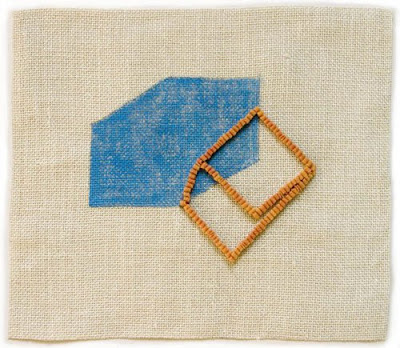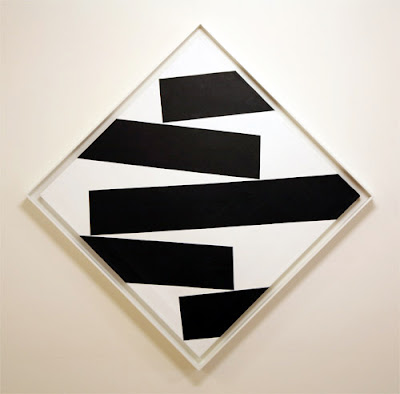.
On Facebook recently I asked my friends who work in geometric abstraction to send me an image of a recent work of theirs in which the diamond or rhomboid is a significant element. I thought that using Facebook in this way would be an interesting angle on an interesting angle. I wasn’t after dictionary precision (rhomboid: a parallelogram with adjacent sides of unequal lengths, or an equilateral parallelogram; diamond: another name for rhombus); I flunked geometry in tenth grade and never looked back. Rather I was, and am, interested in an artist’s visual interpretation of those shapes.
Over the course of a week, some five dozen images appeared in my inbox: compelling shapes united by their geometric aggressiveness, wooze-inducing angles and/or on-point position. Unlike rectilinear shapes with angles perpendicular to a horizontal plane, diamonds and rhomboids are wildly dynamic, punching through their perimeters to capture the space around them or holding it with equipoise, or sometimes both. Elongated shapes play with our perspective. Eccentric angles skew with our perception of plane. Actual dimension further confounds our expectation of planarity.
Louise P. Sloane
Navajo, 1984, encaustic, 48 x 48 inches
Joanne Mattera
Romb, 2011, encaustic on panel, 45 x 45 inches
.
I selected 34 images that appealed to my sensibilities while at the same time underscoring and expanding the concept of the post (the genesis of which is exemplified by my own image, above). The images that best fit my concept found a spot in the lineup; the best of those made me adjust my thinking about the lineup itself, for here the scrolling sequence is how you see the work, a very different visual experience from the white box installation or the catalog page-turn.
The works in this scroll-down reflect a variety of ideas: tectonic shift, Archimedian displacement, spiritual thinking, a textile sensibility, references to the body, constructivist principles, optical challenge, formal push/pull, and the pure pleasure of geometric abstraction. Materiality, another of my interests, is very much in evidence here as well. What follows is a curated post, Rhomboid Rumba.
George Ortman
Blue Diamond, 1961; oil, collage and wood on masonite; 60 x 48 inches
Grace DeGennaro
Indigo Series #38, 2010, gouache on paper, 30 x 22 inches
Karen Freedman
Ruche 0399, 2011, encaustic on panel, 12 x 12 inches
Mary Judge
Tumulus 1, 2011, powdered pigment on folded paper, 8 x 18 inches.
J.T. Kirkland
Fracture_009, 2011, acrylic and polyacrylic on maple plywood, 46 x 23 inches
Evan Read
Untitled (Concentric Rectangles N. 1), 2011, inkjet on photo matte paper, 17 x 32 inches
Laura Moriarty
Sinkhole, 2009, encaustic on panel, 8 x 10 x 6 inches
Gudrun Mertes Frady
Cool Blue, 2009, oil and metallic pigments on wood, 18 x 18 inches
Dennis Meier
2011-04-09 111, 2011, digital image
Don Voisine
Off Register, 2010, oil on wood, 16 x 17 inches; courtesy McKenzie Fine Art, New York City.
Steven Baris
Nested Forms #7, 2011, acrylic on shaped plexiglass, 13 x 13 inches
Marc Cheetham
Untitled, 2011; acrylic, canvas on canvas, 19.5 x 19.5 inches
Richard Bottwin
Facade #6, 2011, ash veneer on birch poly and acrylic color, 17 x 27 x 8 inches
Ted Larsen
Cross Bar, reclaimed steel and annealed wire, 23 x 31 x 3 inches; courtesy Clark Gallery, Lincoln, Mass.
Altoon Sultan
#13, 2011, hand-dyed wool and egg tempera on linen, 11.75 x 13.5 inches
Lynda Ray
Red Trace, 2007, encaustic on panel, 40 x 48 inches
Julie Karabenick
Composition 93, 2010, acrylic on canvas 45 x 45 inches
Sharon Butler
Brightly Colored Separates 2, 2010, oil on canvas, 30 x 40 inches
Jeanne Heifetz
Geometry of Hope: Cobalt, Emerald, 2009, acid-etched glass hand stitched to stainless steel mesh, 20 x 20 inches
Debra Ramsay
In Half Twice, Black with Blue, 2011; various papers, cotton thread, pins; 16 x 10.5 inches
Bernard Klevickas
Untitled (emergence), 2010, cut-up plastic food contrainers and aluminum pop rivets, 19 x 15 x 3 inches
Chris Ashley
Black Drawing 22, 2009, acrylic on paper, 14 x 11 inches
Rachel Beach
Stack, 2010; oil and acrylic on plywood, reclaimed lumber; 51 x 17 x 10 inches
Connie Goldman
Arena 111, 2007, oil on panel, 23.5 x 20
Jeffrey Cortland Jones
Hoke's Run, 2011, enamel on acrylic panel, 12 x 12 inches
Matt Morris
Amuse-bouche, 2009; spray enamel and paint, yarn poppom, map pin on wall; 41 x 96 inches
Oriane Stender
Self/image (large collarbone), 2001, photographs and thread, 31 x 20 inches
Ward Jackson
Point and Line to Plane, 1963, acrylic on canvas, 37 x 37 inches; Courtesy David Richard Contemporary, Santa Fe
Doug Holst
Untitled, 2009, acrylic on wood, 12 x 12 inches
Related post:
My New Best Friends

































































